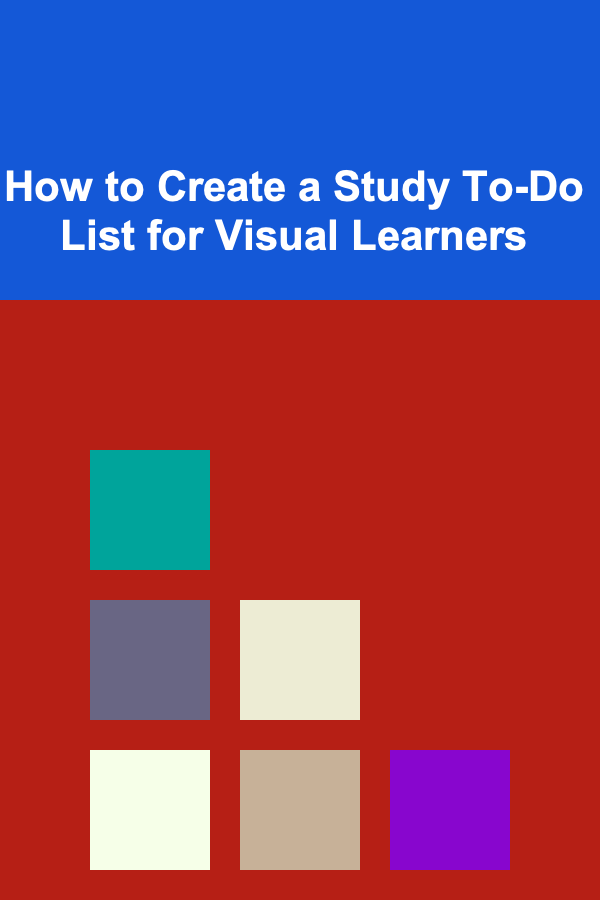
How to Create a Study To-Do List for Visual Learners
ebook include PDF & Audio bundle (Micro Guide)
$12.99$8.99
Limited Time Offer! Order within the next:

Creating an effective study to-do list is crucial for every student, but it becomes particularly important for visual learners. Visual learners process information most effectively when they can see it, whether it's through charts, diagrams, mind maps, or written lists. They are more likely to retain and understand concepts when presented visually, which makes creating an intentional study to-do list especially valuable for them.
This article will guide you through how to design a study to-do list that works for visual learners, providing insights into the types of tools, strategies, and organizational methods that can enhance their study sessions. Whether you are a visual learner yourself or a teacher or parent helping a student, these tips will empower you to maximize productivity and improve retention.
What is a Visual Learner?
A visual learner is someone who prefers to process and absorb information by seeing it. Visual learners often excel when they are presented with diagrams, charts, graphs, or written notes. They can easily recall information they have seen or written down. They might struggle with auditory or kinesthetic forms of learning, and they may not perform as well in environments where they cannot see the material they need to learn.
Key Traits of Visual Learners:
- Prefers written instructions over verbal ones.
- Understands and remembers better through charts, graphs, or diagrams.
- Often benefits from color-coded notes or mind maps.
- Has a strong visual memory and can picture things in their mind.
Understanding these traits helps in tailoring a study plan that leverages their strengths and minimizes the challenges they might face with other learning styles.
Why a Study To-Do List is Essential for Visual Learners
A well-organized study to-do list serves as both a roadmap and a visual reminder of what needs to be done. For visual learners, seeing tasks laid out clearly can help them stay focused, track their progress, and reduce the anxiety that can come with managing multiple assignments or deadlines.
The study to-do list should not only contain tasks to complete but should also be visually structured in a way that aligns with the cognitive preferences of visual learners. By using color coding, symbols, and other visual aids, a to-do list can make the entire study process more manageable, engaging, and effective.
Benefits of a Study To-Do List for Visual Learners:
- Improved focus: Having a visual layout of tasks can help a visual learner focus on one thing at a time.
- Task prioritization: A well-organized list helps learners see what is urgent and what can wait.
- Reduced stress: Breaking down tasks into manageable steps reduces feelings of overwhelm.
- Visual tracking: The ability to visually track progress encourages motivation and a sense of accomplishment.
- Memory reinforcement: Writing things down and visually organizing them helps reinforce memory retention.
By understanding how visual learners engage with tasks, we can begin to create a study to-do list that caters to these needs.
How to Create an Effective Study To-Do List for Visual Learners
Now that we understand the benefits of a study to-do list, it's time to explore how to create one that is tailored to visual learners. The key lies in utilizing visual elements that make the list easier to navigate and more enjoyable to engage with. Below are strategies that will help visual learners make the most out of their study time.
1. Break Down Large Tasks into Smaller, Visual Steps
Visual learners often feel overwhelmed by big tasks or projects, especially if they can't easily see a path forward. By breaking larger tasks into smaller, digestible steps, you create a visual map of the process, which makes the project feel less intimidating.
Example:
Instead of writing "Prepare for final exam," break it down:
- Review Chapter 1 (highlighted in yellow)
- Create mind map of key concepts from Chapter 1 (add a box or circle around this task)
- Take practice quiz on Chapter 1 (use a checkbox to mark completion)
This segmented approach helps a visual learner see immediate next steps and keeps them focused on one task at a time. The use of colors, boxes, or circles further organizes each task visually.
2. Use Color Coding for Different Subjects or Priorities
Color coding can significantly improve a visual learner's ability to organize and prioritize tasks. By assigning different colors to different subjects, deadlines, or levels of importance, you create a clearer visual hierarchy that allows the learner to see what needs attention most.
Example:
- Red for urgent or high-priority tasks (e.g., upcoming tests).
- Blue for assignments that are important but not immediate.
- Green for tasks that are low priority or long-term goals.
- Yellow for tasks related to review or practice.
Color coding works because it taps into a visual learner's preference for categorizing and distinguishing information visually. This method also ensures that tasks of greater importance are immediately identifiable.
3. Incorporate Visual Tools Like Charts and Diagrams
Visual learners thrive when they can see information laid out in charts, diagrams, or other graphic forms. Instead of just listing tasks, consider using these types of visuals in your to-do list.
Example:
- Gantt Chart: Create a simple Gantt chart for your study plan to track deadlines and progress visually.
- Flowchart: Use a flowchart to map out the steps for a particular project or study session. This can help break down tasks in a logical, sequential manner.
- Venn Diagrams: Use Venn diagrams to compare and contrast information, especially useful for subjects like history, biology, or even writing essays.
Incorporating these visual tools helps your child or student understand relationships between concepts, see connections, and better process information.
4. Use Sticky Notes or Visual Reminders
Sticky notes are an excellent way to implement a visual reminder system. Visual learners can easily place sticky notes around their study area, whether on their desk, wall, or computer monitor, so they're constantly reminded of tasks they need to complete.
Example:
- Place sticky notes with specific reminders like "Review key terms in Biology," "Complete math practice problems," or "Finalize essay draft."
- Color-code sticky notes to reflect urgency or importance.
By making tasks visible in multiple areas, you're reinforcing them and keeping them top of mind. This method works particularly well in a home study environment where students can personalize their reminders.
5. Use Checkboxes or Symbols for Task Tracking
Visual learners tend to enjoy checking off completed tasks, and using checkboxes or symbols in a study to-do list can offer instant gratification. By adding checkboxes to the list, students can see the physical progress they are making.
Example:
- Use a checkbox for each task on the list: [ ] Review Chapter 3, [ ] Complete worksheet 5, [ ] Start essay draft.
- Consider using other symbols like arrows, stars, or exclamation marks to highlight particularly important tasks.
Visually checking off tasks not only reinforces the completion of each item but also provides a visual representation of progress, which can boost motivation.
6. Create Mind Maps or Visual Flowcharts for Complex Concepts
For more complex subjects, creating a mind map or flowchart is a great way to organize information visually. This strategy helps students understand how ideas or concepts are interconnected, allowing them to see the "big picture."
Example:
- Create a mind map to break down key topics in a subject like biology, with branches for each subtopic.
- Use a flowchart for historical events, illustrating cause-and-effect relationships between events.
Mind maps and flowcharts can be integrated into the study to-do list or used separately for deeper learning on complex topics.
7. Prioritize Tasks Using a Visual Matrix
The Eisenhower Matrix is a time management tool that visually categorizes tasks based on their urgency and importance. This method helps a visual learner easily decide which tasks to focus on first.
Example:
Divide your to-do list into four quadrants:
- Urgent and Important: Tasks that need to be done immediately (e.g., preparing for an exam tomorrow).
- Important but Not Urgent: Tasks that should be scheduled for later (e.g., studying for a midterm in a week).
- Urgent but Not Important: Tasks that can be delegated (e.g., responding to emails).
- Neither Urgent Nor Important: Tasks that can be postponed or ignored (e.g., organizing your study materials for the semester).
The visual separation of tasks based on urgency and importance makes it easier for visual learners to prioritize and stay on track.
8. Set Visual Goals and Deadlines
For visual learners, seeing deadlines and goals can enhance their focus and motivation. Consider adding a visual timeline or calendar to the to-do list, allowing them to track progress over time.
Example:
- Use a wall calendar or digital planner with color-coded deadlines for each subject.
- Include visual markers like flags or stickers to indicate upcoming due dates.
- Set visual milestones for larger projects, with clear goals at each step (e.g., "Research completed," "First draft done," etc.).
Visual goals give students a concrete sense of where they are in their study process, helping them stay motivated as they approach important milestones.
9. Include Visual References and Resources
Along with your study to-do list, include a section for visual references and resources that might be helpful. For visual learners, having easy access to helpful diagrams, charts, and visuals can improve their understanding of the material.
Example:
- Attach links or printouts of study guides, diagrams, or instructional videos next to relevant tasks.
- Organize your study space with posters or flashcards that highlight key concepts or formulas.
By keeping visual aids accessible, students are better able to engage with the material, reinforcing what they've learned through various visual formats.
10. Review and Adjust the To-Do List Regularly
A study to-do list is a dynamic tool, and it should evolve as students make progress or encounter new tasks. Visual learners benefit from the ability to review their progress visually, so regularly updating the list and tracking what's been completed is essential.
Example:
- Review the list at the end of each study session and check off completed tasks.
- Adjust the list daily to reflect new priorities or deadlines.
- Update any visual tools (e.g., Gantt charts, mind maps) as tasks evolve.
An adaptable to-do list helps visual learners stay organized and ensures they don't miss important deadlines.
Conclusion
Creating an effective study to-do list for visual learners involves more than just writing down tasks. By utilizing color coding, visual diagrams, flowcharts, and other visual elements, you can help students maximize their productivity, stay focused, and retain information more effectively. The key is to make the to-do list not only functional but also visually engaging, allowing visual learners to process and internalize the information in a way that works best for them.
By following these strategies and customizing the to-do list to suit individual preferences, you can empower visual learners to take charge of their study sessions and achieve their academic goals without feeling overwhelmed.
Reading More From Our Other Websites
- [Home Cleaning 101] How to Tackle a Cluttered Garage and Keep It Tidy
- [Personal Care Tips 101] How to Combine a Facial Cleanser with Toners and Moisturizers for Better Results
- [Tiny Home Living Tip 101] Best Compact HVAC Systems for Year‑Round Comfort in Small Dwellings
- [Home Pet Care 101] How to Maximize Your Pet's Experience at the Pet Care Palace
- [Scrapbooking Tip 101] From Snapshots to Stories: Creative Photo Layouts for Your Next Scrapbook
- [Organization Tip 101] How to Handle Moving Difficult Items Like Pianos or Artwork
- [Personal Care Tips 101] How to Select the Best Hair Oil for Dry Hair
- [Weaving Tip 101] Step-by-Step Techniques for Creating Intricate Patterns in Blanket Weaving
- [Home Staging 101] How to Use Plants and Greenery to Liven Up Spaces
- [Organization Tip 101] How to Incorporate Natural Elements into Your Jewelry Display

How to Plan a Closet Makeover on a Budget
Read More
How to Set a Budget for Your Home Renovation
Read More
How to Use Folders and Tags for Efficient File Management
Read More
How to Manage Portions for Healthy Eating
Read More
Building a Strong Employer Brand: A Deep Dive
Read More
10 Tips for Running Successful Tennis Clinics and Camps
Read MoreOther Products

How to Plan a Closet Makeover on a Budget
Read More
How to Set a Budget for Your Home Renovation
Read More
How to Use Folders and Tags for Efficient File Management
Read More
How to Manage Portions for Healthy Eating
Read More
Building a Strong Employer Brand: A Deep Dive
Read More